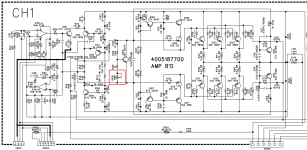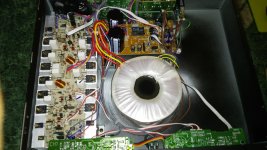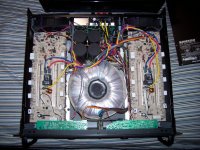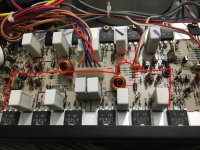Hello, just another BIAS adjustment question for any of the pro/experts here in solid-state Class A/B amplifiers.
Between an really old-school here and own 4 heavy-iron Samson amplifiers, the discontinued well built S line 1x S500, 1x S700 and 2x S2000 as I really like the warmth sounding of this units especially the S500.
I running fully active 3-way using 1x S2000 for the subs, 1x S700 for the mids and 1x S500 for highs.
So the main question here is if some expert in this topic can confirm if the VR101 POT in the S500 schematic picture is the BIAS adjustment or just the offset voltage adjustment, I will also attach the schematic diagrams of the Samson S line amps as all of them looks almost identical to me in regards topology/design.
P.S. I've recently recapped the PS of the S500/S700 units with 10,000uF 80v Elna caps but I was reading about BIAS re-adjust as well, though I have to measure them first but just want be sure about the VR101 POT, since I'm thinking on populate the disabled transistors on the S700 unit probably I will have to readjust the BIAS in that unit mainly.
Regards!
Samson S500 POT VR101:

Samson S500 inside:

Samson S700 inside:

Samson S2000 inside:

Between an really old-school here and own 4 heavy-iron Samson amplifiers, the discontinued well built S line 1x S500, 1x S700 and 2x S2000 as I really like the warmth sounding of this units especially the S500.
I running fully active 3-way using 1x S2000 for the subs, 1x S700 for the mids and 1x S500 for highs.
So the main question here is if some expert in this topic can confirm if the VR101 POT in the S500 schematic picture is the BIAS adjustment or just the offset voltage adjustment, I will also attach the schematic diagrams of the Samson S line amps as all of them looks almost identical to me in regards topology/design.
P.S. I've recently recapped the PS of the S500/S700 units with 10,000uF 80v Elna caps but I was reading about BIAS re-adjust as well, though I have to measure them first but just want be sure about the VR101 POT, since I'm thinking on populate the disabled transistors on the S700 unit probably I will have to readjust the BIAS in that unit mainly.
Regards!
Samson S500 POT VR101:

Samson S500 inside:

Samson S700 inside:

Samson S2000 inside:

Attachments
Yes, with the marked pot you can adjust the bias current.
A DC Servo to eliminate DC on the output usually is an integrating opamp circuit that is parallel to the feedback resistors.
A DC Servo to eliminate DC on the output usually is an integrating opamp circuit that is parallel to the feedback resistors.
Yes, with the marked pot you can adjust the bias current.
A DC Servo to eliminate DC on the output usually is an integrating opamp circuit that is parallel to the feedback resistors.
Hi, thank you for the quick response and to confirm that the VR101 is the BIAS adjustment POT in this old amplifiers.
Also yes, I was reading and looking diagrams about the servo circuit time ago and indeed this units can be easily modded since is old thru-hole circuit, though the S500 units is quite silent and I need to put my ear in the horns in order to hear a slight hiss with the input levels at max, but of course with the XLR input shorted.
However I put my meter into 200mV scale, the S500 measured 1.4mV CH1 and 0.6mV CH2, roughly 0.8mV channel difference, non sure if I should bother or not since seems rather low but improvements are always welcome.
Thanks again.
Regards
My understanding for setting the bias current is that it is a risky thing because you have to consider the SOA curve of the output transistors, the thermal ability of your heatsink, thermal runaway can be an issue and these things can lead to instability or stress to your parts.
So just increasing the BIAS current is risky.
Setting a lower bias current will result in higher harmonics on the other hand.
If these values are the DC offset on the outputs it looks like the amp has a DC servo which might be IC101-B.
So just increasing the BIAS current is risky.
Setting a lower bias current will result in higher harmonics on the other hand.
If these values are the DC offset on the outputs it looks like the amp has a DC servo which might be IC101-B.
My understanding for setting the bias current is that it is a risky thing because you have to consider the SOA curve of the output transistors, the thermal ability of your heatsink, thermal runaway can be an issue and these things can lead to instability or stress to your parts.
So just increasing the BIAS current is risky.
Setting a lower bias current will result in higher harmonics on the other hand.
If these values are the DC offset on the outputs it looks like the amp has a DC servo which might be IC101-B.
I agree, setting above the average bias may stress the finals or even blown them from thermal issues not to mention the wasted idle power, between I was just reading this old thread How do I adjust amp bias? but definitely I will leave the bias as is on the S500 which is the compression drivers amp as I haven't noticed distortion running at low volume so far.
OTOH I was planing to populate the missing transistors(4x on each channel) and the required parts(few resistors and jumpers) on the S700 as previously denoted just to make it 10 outputs finals per channel(like the S1000) instead 6 per channel.
Though that mod may just increase dissipation and damping factor regarding another old thread, however I thinking now to leave it as is since read that adding extra outputs may also cause oscillations plus the risky bias re-adjust etc, so is not as simple as it seems and don't want to change parts either.
Also yes the DC offset values I've posted from the S500 was taken from the amplifier outputs with no load connected and the input volume pots at 12 o'clock.
Regards
Update:
I was being curious here and decided to open the S500 to measure the bias mV across outputs emitters, and found that the amp A has about ~8.7mV and the amp B has about ~ 6.4mV (0.47ohms resistors), this was with the cover open fan disconnected and letting the heatsink several minutes to get abit warm to the touch.
Test points I've used:

Also found that the bias in this amplifier rises when cool, so what I did was to play with the pots carefully and set the bias in the amp A to ~10.6mV and 9.2mV on the amp B, that was the best I could do since playing with one pot affected the other amplifier bias and vice versa and reached one point where I could not match them perfectly any more, then after letting the heatsink cool down and with the fan on the unit connected as it should the bias voltage across the output emitters rises to about ~15.5mV on amp A and ~ 14.1mV on the amp B, the outputs offset voltage remained below 1.7mV which is good to know.
So looks like this pro amp rises the bias when cool and decreases it a bit when getting hotter/stressed, and that was a nice finding since I was planning to disconnect the fan since the heatsink was just warm to the touch, but since this is the highs amplifier driving the high-sensitivity compression drivers from 1kHz-up and since this amplifier is always idle/cool the higher bias should do better job hopefully.
I was still about skeptical on the bias setting I did, so I just grabbed my iPhone and connected it to the amp and connected my headphones to the amplifier outputs for a listen, listening with very low volume level to some Pop and Rock songs and I didn't noticed any crossover distortion and the sound was just hi-fi, though just a very slight hiss in the background when not playing music which is expected due the headphones sensitivity, so to my old ears it sounded pretty much like my Magni Heresy headphone amplifier except for the slight hiss as denoted, though this are simply my assumptions.
So lesson learned on leave the fan connected in this S500 amplifier since it run always quite for my application, and hopefully there will be no issues in the long run with the small bias adjust.
Regards
I was being curious here and decided to open the S500 to measure the bias mV across outputs emitters, and found that the amp A has about ~8.7mV and the amp B has about ~ 6.4mV (0.47ohms resistors), this was with the cover open fan disconnected and letting the heatsink several minutes to get abit warm to the touch.
Test points I've used:

Also found that the bias in this amplifier rises when cool, so what I did was to play with the pots carefully and set the bias in the amp A to ~10.6mV and 9.2mV on the amp B, that was the best I could do since playing with one pot affected the other amplifier bias and vice versa and reached one point where I could not match them perfectly any more, then after letting the heatsink cool down and with the fan on the unit connected as it should the bias voltage across the output emitters rises to about ~15.5mV on amp A and ~ 14.1mV on the amp B, the outputs offset voltage remained below 1.7mV which is good to know.
So looks like this pro amp rises the bias when cool and decreases it a bit when getting hotter/stressed, and that was a nice finding since I was planning to disconnect the fan since the heatsink was just warm to the touch, but since this is the highs amplifier driving the high-sensitivity compression drivers from 1kHz-up and since this amplifier is always idle/cool the higher bias should do better job hopefully.
I was still about skeptical on the bias setting I did, so I just grabbed my iPhone and connected it to the amp and connected my headphones to the amplifier outputs for a listen, listening with very low volume level to some Pop and Rock songs and I didn't noticed any crossover distortion and the sound was just hi-fi, though just a very slight hiss in the background when not playing music which is expected due the headphones sensitivity, so to my old ears it sounded pretty much like my Magni Heresy headphone amplifier except for the slight hiss as denoted, though this are simply my assumptions.
So lesson learned on leave the fan connected in this S500 amplifier since it run always quite for my application, and hopefully there will be no issues in the long run with the small bias adjust.
Regards